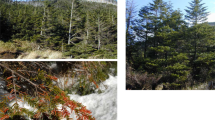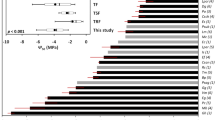Abstract
The mechanism of freeze stress-induced embolism in Fagus sylvatica L. branches was analyzed under controlled conditions. Excised branches were exposed to successive freeze-thaw cycles in temperature controlled chambers. Thermocouples were placed on the bark to detect sap freezing exotherms. The degree of xylem embolism was estimated after each cycle by the loss of hydraulic conductivity. After one freeze-thaw cycle the degree of embolism was found to decrease with xylem specific hydraulic conductivity, small apical shoots being more susceptible to embolism. Exotherms revealed that distal shoots were freezing first and exuded sap as a result of water expansion. The lower water content in apical shoots upon freezing probably induced higher sap tensions which promoted air bubble expansion and vessel cavitation preferentially near the apices. When the decrease in water content was experimentally prevented, embolism developed to a lesser extent. The higher vulnerability of shoot apices may protect the rest of the branch from winter damage.
Similar content being viewed by others
Author information
Authors and Affiliations
Additional information
Received: 29 May 1998 / Accepted: 15 August 1998
Rights and permissions
About this article
Cite this article
Lemoine, D., Granier, A. & Cochard, H. Mechanism of freeze-induced embolism in Fagus sylvatica L.. Trees 13, 206–210 (1999). https://doi.org/10.1007/PL00009751
Issue Date:
DOI: https://doi.org/10.1007/PL00009751




